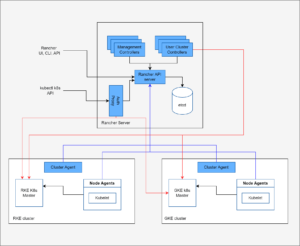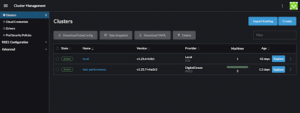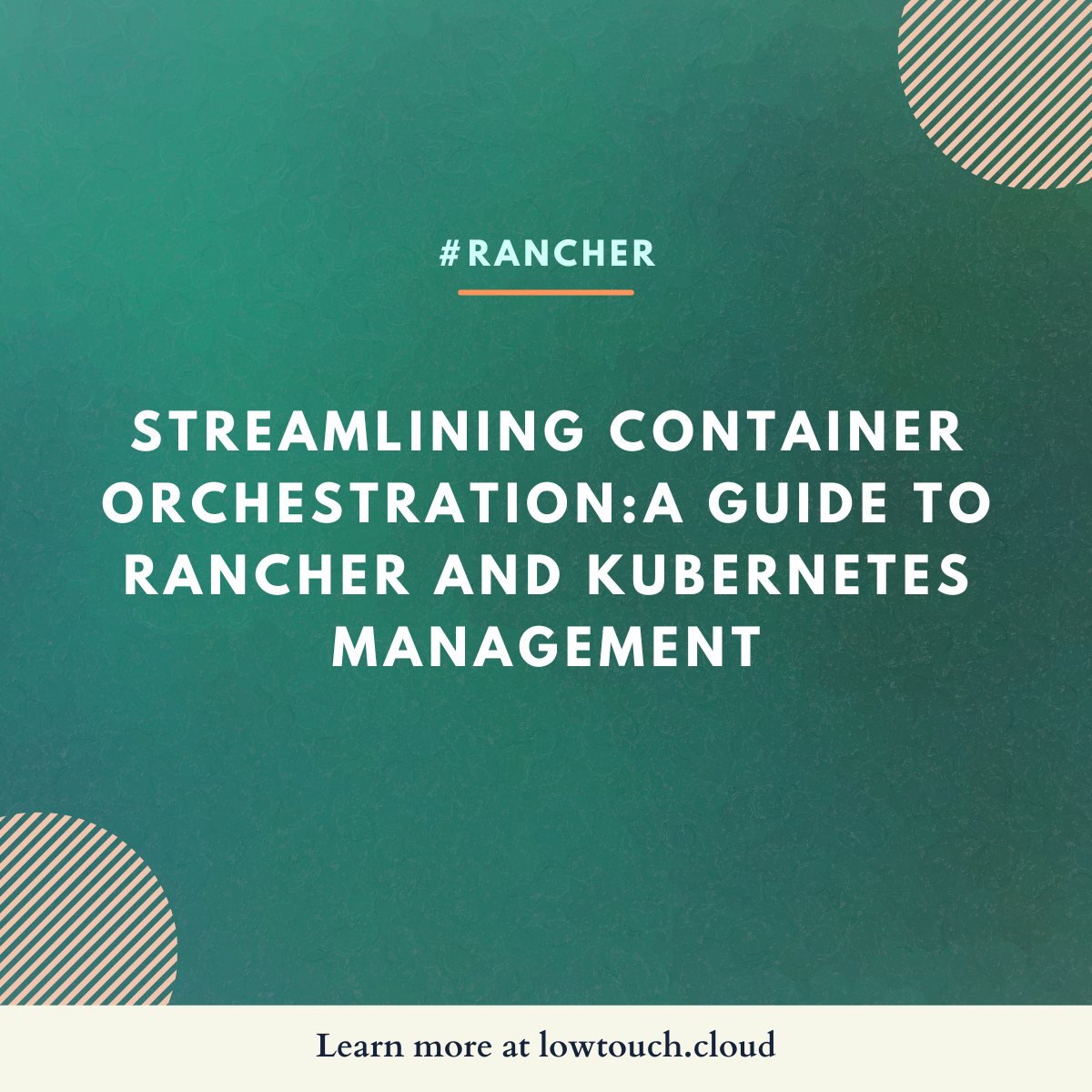Streamlining Container Orchestration: A Guide to Rancher and Kubernetes Management
1. Introduction
In the ever-evolving landscape of container management, Rancher emerges as a game-changer. With its pioneering open-source platform Rancher, Rancher Labs has redefined how we manage containerized applications, especially those orchestrated through Kubernetes. Rancher is a robust open-source platform that simplifies the management of Kubernetes clusters. It offers a user-friendly interface, enabling organizations to deploy, manage, and scale containerized applications effortlessly. Rancher’s intuitive approach to Kubernetes management makes it an ideal choice for beginners and experienced users in the container orchestration landscape.
Rancher is designed to streamline the management of containerized applications. It provides deployment flexibility across various cloud providers and clusters, allowing users to interact with multiple clusters through a single user interface. Rancher’s centralized control, authentication, and role-based access facilitate efficient management of clusters.
2. Components
Rancher comprises several key components that work seamlessly to provide a powerful Kubernetes management solution. These components include:
- Rancher Server: The central management hub that orchestrates and controls multiple Kubernetes clusters.
- Rancher Agent: Installed on each cluster node, it facilitates communication between the Rancher server and the clusters.
- Cattle: Rancher’s original orchestration engine that manages containers and clusters.
- Rancher CLI: A command-line interface for advanced users to interact with Rancher programmatically.
- Rancher Catalog: A collection of pre-defined application templates and configurations simplifying the deployment process.

Fig 1: Rancher Components
3. Rancher Dashboard
Rancher Cluster, a robust platform in Kubernetes management, offers a unique experience distinct from the typical Kubernetes Dashboard. While Kubernetes Dashboard provides insights into running pods, services, and other components within a specific cluster, Rancher Cluster takes it further by seamlessly integrating multiple Kubernetes and Rancher clusters. This integration extends beyond just Kubernetes; it accommodates GKE, AKS, EKS, and other K8s clusters, making Rancher versatile in the container management landscape.
In Rancher Cluster, the user experience is elevated to a new level. It functions as an autonomous entity with its own masters and ETC database, offering a tailored and user-friendly interface. The beauty of Rancher lies in its simplicity – it eliminates the need for users to access consoles or terminals to execute commands or configure settings. Whether it’s a Rancher Cluster, a Rancher Kubernetes Engine, or a plain micro K8 cluster, integrating it into Rancher is a seamless process.
Once integrated, Rancher provides unparalleled control over the added clusters. Users gain visibility into every facet of the cluster, from understanding the roles of various components to managing deployments and services. The Rancher Cluster interface acts as a centralized hub, empowering users to oversee activities, roles, and deployments effortlessly. Pod management becomes intuitive – deleting a pod is just a click away. Accessing pod logs is equally straightforward; users can view real-time logs without the hassle of additional configurations. Clicking on a specific pod offers an instant glimpse into its current activity, ensuring efficient troubleshooting and monitoring.
In essence, Rancher Cluster is more than just a management tool; it’s an organized solution designed to seamlessly handle the complexities of multiple Kubernetes clusters. The Rancher dashboard provides users with a clean, intuitive interface that simplifies cluster management, making it an indispensable asset for any organization navigating the intricate Kubernetes landscape.

Fig 2: Rancher Dashboard
4. Rancher Cluster
A Rancher Cluster is a group of servers or nodes configured to work as a unified entity for container orchestration within the Rancher platform. These clusters are essential components in Rancher’s architecture, allowing seamless management and deployment of containerized applications.
Rancher Clusters serves as a Rancherackbone of Rancher’s container management platform, offering organizations a powerful solution to manage, deploy, and scale containerized applications efficiently. With its versatile deployment options, robust security features, and integration capabilities, Rancher Clusters empowers businesses to thrive in the rapidly evolving landscape of container orchestration.
4.1 Purpose of the Rancher Cluster
The primary purpose of a Rancher Cluster is to streamline the administration and deployment of containerized applications, particularly those orchestrated through Kubernetes. By organizing servers into clusters, Rancher provides a centralized control plane that simplifies complex tasks related to container management, ensuring scalability, efficiency, and ease of use.
4.2 Use Cases of the Rancher Cluster
- Managing Complex Applications: Rancher Clusters are ideal for managing intricate applications with multiple microservices. The platform simplifies the deployment and scaling of these applications, ensuring seamless operation.
- Consistent Deployments Across Environments: Rancher Clusters enable organizations to maintain consistency in deployments across different environments, ensuring that applications run uniformly, whether in development, testing, or production environments.
- Enhanced User Access Control and Security: Rancher Clusters facilitate robust user access control and security measures, allowing administrators to define roles and permissions and ensuring that only authorized personnel can access and modify critical resources within the clusters.
4.3 Deployment Options of the Rancher Cluster
Rancher Clusters offer versatile deployment options to cater to diverse infrastructures, including:
- On-Premises Data Centers: Rancher can be deployed on local data center servers, providing organizations with complete control over their infrastructure and ensuring data privacy and security.
- Public Cloud Providers (AWS, Azure, GCP): Rancher integrates with major public cloud providers, allowing organizations to leverage cloud resources and scalability while managing containers efficiently.
- Virtualization Platforms: Rancher supports various virtualization platforms, enabling users to create Rancher Clusters within virtual machines, providing flexibility and ease of deployment.
4.4 Benefits of Using a Rancher Cluster
- Simplified Container Management: Rancher Clusters simplify the complexities of container management, providing a user-friendly interface for configuring, deploying, and scaling applications.
- Centralized Control and Monitoring: Rancher Clusters offer centralized control, allowing administrators to manage multiple clusters through a unified dashboard. Additionally, Rancher provides robust monitoring tools to keep track of cluster health and performance.
- Enhanced Scalability: Rancher Clusters are designed to handle large-scale deployments, ensuring that organizations can scale their applications effortlessly as their requirements grow.
Integration Capabilities: Rancher Clusters seamlessly integrate with various tools and services, enabling organizations to enhance their workflows, implement CI/CD pipelines, and streamline development processes.
5. Difference between Rancher and Kubernetes
While Kubernetes offers powerful container orchestration capabilities, Rancher enhances its usability and scalability by providing an intuitive management layer, making it accessible to a broader range of users and facilitating seamless Kubernetes cluster operations.
5.1 Kubernetes manages containers within clusters:
Kubernetes, developed by Google, is an open-source container orchestration platform that automates the deployment, scaling, and management of containerized applications. It organizes containers into clusters, allowing users to efficiently manage individual containers and their interconnections within a controlled environment.
5.2 Rancher manages Kubernetes clusters at scale:
Rancher acts as a management layer specifically designed to handle Kubernetes clusters at scale. It provides a unified interface to manage multiple Kubernetes clusters effortlessly, ensuring consistent management practices across various deployments.
5.3 Kubernetes is an open-source container orchestration platform:
Kubernetes is a popular open-source platform maintained by the Cloud Native Computing Foundation (CNCF). It offers a rich set of features for orchestrating containers, including load balancing, auto-scaling, self-healing, and rolling updates, making it a preferred choice for container orchestration in the industry.
5.4 Rancher is not a replacement for Kubernetes but a management layer:
Rancher is not a replacement for Kubernetes; instead, it serves as a management layer on top of Kubernetes clusters. It simplifies Kubernetes’s deployment, configuration, and scaling, providing an intuitive interface for users to interact with and manage their containerized applications.
5.5 Kubernetes offers extensive container orchestration features:
Kubernetes provides a comprehensive set of features for container orchestration, including declarative configuration, service discovery, storage orchestration, automated rollouts, and rollbacks. It caters to complex deployment scenarios and ensures high availability and fault tolerance of applications.
5.6 Rancher simplifies Kubernetes cluster deployment and operations:
Rancher simplifies the complexities of deploying and managing Kubernetes clusters. It automates various tasks, such as cluster provisioning, scaling, monitoring, and upgrades, making it easier for users to handle large-scale Kubernetes deployments without delving into intricate technical details.
5.7 Kubernetes requires manual cluster configuration and management:
Setting up and managing a Kubernetes cluster involves manual configuration of YAML files defining pod specifications, services, and other resources. Users must handle cluster upgrades, scaling, and monitoring configurations, which can be time-consuming and challenging, especially for beginners.
5.8 Rancher provides a user-friendly web-based interface:
Rancher offers a user-friendly web-based interface that simplifies Kubernetes cluster management. Through this interface, users can visually configure clusters, deploy applications, manage nodes, and monitor cluster health without requiring extensive command-line expertise.
5.9 Kubernetes is used for deploying and managing containerized applications:
Kubernetes focuses on deploying and managing containerized applications, providing a robust platform for orchestrating microservices and ensuring their reliable execution, scaling, and networking within a cluster.
5.10 Rancher is used as a tool to simplify Kubernetes operations, especially in large-scale environments:
Rancher is a valuable tool for organizations, especially in large-scale environments, where managing multiple Kubernetes clusters efficiently is crucial. It abstracts the complexities of Kubernetes, offering a streamlined approach to deployment and operations, allowing users to concentrate on building and deploying applications rather than managing the underlying infrastructure.
6. Conclusion
Rancher emerges as a pivotal solution in the dynamic realm of container management, augmenting Kubernetes operations with its intuitive interface and versatile functionalities. Rancher simplifies complexities inherent in managing containerized applications by seamlessly integrating multiple clusters and offering centralized control. Its ability to streamline deployment across diverse environments, coupled with robust security measures, underscores its significance in modern IT landscapes. While Kubernetes provides the foundation, Rancher enhances usability, scalability, and accessibility, empowering organizations to navigate the intricacies of container orchestration effectively. As the demand for efficient cluster management continues to surge, Rancher stands as a testament to innovation, offering a cohesive platform that caters to the evolving needs of containerized infrastructures.
About the Author

Nagesh A
Head of Delivery | Cloud Control
Head of Delivery with more than five years of experience in supporting, automating, and optimizing deployments to hybrid cloud platforms using DevOps processes, CI/CD, containers, and Kubernetes in both Production and Development environments

